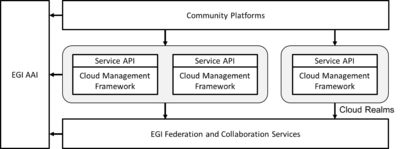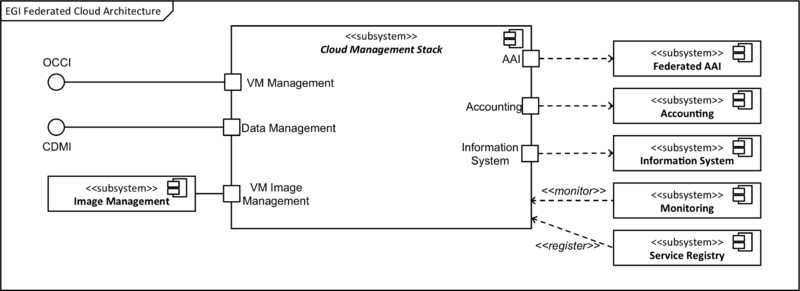Difference between revisions of "Federated Cloud Technology"
| Line 20: | Line 20: | ||
Every cluster of the federation defines the actual level of integration with the EGI Federated Operations Services, the EGI marketplace and their Federated AAI architecture and technologies. The IaaS services of the cluster must be offered with interfaces that assure the interoperability within the community and whenever possible open standards should be used. The EGI Federated Operations services include the following: | Every cluster of the federation defines the actual level of integration with the EGI Federated Operations Services, the EGI marketplace and their Federated AAI architecture and technologies. The IaaS services of the cluster must be offered with interfaces that assure the interoperability within the community and whenever possible open standards should be used. The EGI Federated Operations services include the following: | ||
* Information | * [[Federated Cloud Architecture#Information_discovery:_BDII|Information discovery(BDII)]]: The EGI Information Discovery allows users and tools to look for the services that provide the capabilities and the resources to run their activities. It's based on [https://www.ogf.org/documents/GFD.147.pdf OGF GLUE2] and uses LDAP as protocol. | ||
* Accounting: EGI collects all the CPU and storage information to the [[Accounting Repository]]. These data is also provided in a web-based [[Accounting Portal]] where users and VO managers have a detailed view of the resources consumed. | * [[Federated Cloud Architecture#Accounting|Accounting]]: EGI collects all the CPU and storage information to the [[Accounting Repository]]. These data is also provided in a web-based [[Accounting Portal]] where users and VO managers have a detailed view of the resources consumed. | ||
* Monitoring: Resources in the infrastructure are monitored via the [[SAM|Service Availability Monitoring (SAM)]] system that periodically executes tests on the provided services. The results of the tests are used to calculate Availability and Reliability of the resources. | * [[Federated Cloud Architecture#Monitoring:_SAM|Monitoring (SAM)]]: Resources in the infrastructure are monitored via the [[SAM|Service Availability Monitoring (SAM)]] system that periodically executes tests on the provided services. The results of the tests are used to calculate Availability and Reliability of the resources. | ||
* Central | * [[Federated Cloud Architecture#Central_service_registry:_GOCDB|Central service registry (GOCDB)]]: [[GOCDB]] contains general information about the sites participating to the production infrastructure. It collects information about different entities such as the Operations Centres, the Resource Centres, service endpoints and the contact information and roles of people responsible for operations at different levels. | ||
The EGI MarketPlace | The EGI MarketPlace provides [[Federated Cloud Architecture#VM_Image_management|VM Image management]] implemented in the [[AppDB|EGI Applications Database]]. AppDB provides a central registration point for virtual appliances which can be endorsed by VO managers and automatically and securely distributed to any resource provider subscribed to the VO virtual appliance lists. | ||
== Public Federated Cloud == | == Public Federated Cloud == | ||
| Line 87: | Line 87: | ||
| Yes | | Yes | ||
|} | |} | ||
== Community Federated Cloud == | == Community Federated Cloud == | ||
| Line 93: | Line 92: | ||
A community cloud is accessible to a selected group of users or Virtual Organizations. These clouds have a looser federation model hence the level of integration with the EGI services depends on the needs of the community it serves. Community clouds may also choose the interfaces to access the IaaS capabilities as long as the selected interfaces assure the interoperability within the federated resources. The standards used in the Public Federated Cloud are recommended if there are no requirements that prevent their usage. | A community cloud is accessible to a selected group of users or Virtual Organizations. These clouds have a looser federation model hence the level of integration with the EGI services depends on the needs of the community it serves. Community clouds may also choose the interfaces to access the IaaS capabilities as long as the selected interfaces assure the interoperability within the federated resources. The standards used in the Public Federated Cloud are recommended if there are no requirements that prevent their usage. | ||
Community clouds may profit the existing developments for the integration of Cloud Management stacks into the public federated cloud. | Community clouds may profit the existing developments for the integration of Cloud Management stacks into the public federated cloud documented in the [[Federated Cloud resource providers support]] page. | ||
=== OpenStack Community Cloud === | |||
[[Category:Federated_Cloud]] | [[Category:Federated_Cloud]] | ||
Revision as of 11:00, 29 May 2015
| Overview | For users | For resource providers | Infrastructure status | Site-specific configuration | Architecture |
Introduction
The current high throughput model of grid computing has proven to be extremely powerful for a small number of different communities. These communities have thrived in the current grid environment but the uptake of e-infrastructure by other communities has been limited. EGI has therefore strategically decided to investigate how it could broaden the uptake of its infrastructure to support other research communities and application design models, that would not only be able to take advantage of the existing functionality and investment already made in EGI’s Core Infrastructure, but also support different research communities and their applications on the current production infrastructure than it was previously able to.
The utilization of Virtualization and Infrastructure as a Service (IaaS) cloud computing was a clear candidate to enable this transformation. It was also clear that with a number of different open source technologies already in use across a number of different resource providers, that it would not be possible to mandate a single software stack. Instead, following on from a number of different activities already on-going in Europe including SIENA1, an approach that required the utilization of open standards where available and, where not, methods that have broad acceptance in the e-infrastructure community were essential.
This led to the current EGI Cloud Federation model, a model based on the needs of each community using the IaaS cloud as described below.
Federation Model
The EGI Federated Cloud is a set of Resource Providers clusters targeting global or specific user communities: a Public Federated Cloud open for any researcher and various Community Clouds accessible to one or more selected Virtual Organizations. Every cluster follows the model shown in the figure:
The federation of IaaS Cloud resources in EGI is built upon the extensive autonomy of Resource Providers in terms of ownership of exposed resources. The federation model for distributed IaaS Cloud resources allows a lightweight aggregation of local Cloud resources into the EGI Cloud Infrastructure Platform (CLIP). At the heart of the federation are the locally deployed Cloud Management stacks. In compliance with the Cloud computing model, the EGI CLIP does not mandate deploying any particular or specific Cloud Management stack; it is the responsibility of the Resource Providers to investigate, identify and deploy the solution that fits best their individual needs for as long as the offered services implement the required interfaces and domain languages. These interfaces and domain languages, and the interoperability of their implementation with other solutions are the focus of the federation.
Every cluster of the federation defines the actual level of integration with the EGI Federated Operations Services, the EGI marketplace and their Federated AAI architecture and technologies. The IaaS services of the cluster must be offered with interfaces that assure the interoperability within the community and whenever possible open standards should be used. The EGI Federated Operations services include the following:
- Information discovery(BDII): The EGI Information Discovery allows users and tools to look for the services that provide the capabilities and the resources to run their activities. It's based on OGF GLUE2 and uses LDAP as protocol.
- Accounting: EGI collects all the CPU and storage information to the Accounting Repository. These data is also provided in a web-based Accounting Portal where users and VO managers have a detailed view of the resources consumed.
- Monitoring (SAM): Resources in the infrastructure are monitored via the Service Availability Monitoring (SAM) system that periodically executes tests on the provided services. The results of the tests are used to calculate Availability and Reliability of the resources.
- Central service registry (GOCDB): GOCDB contains general information about the sites participating to the production infrastructure. It collects information about different entities such as the Operations Centres, the Resource Centres, service endpoints and the contact information and roles of people responsible for operations at different levels.
The EGI MarketPlace provides VM Image management implemented in the EGI Applications Database. AppDB provides a central registration point for virtual appliances which can be endorsed by VO managers and automatically and securely distributed to any resource provider subscribed to the VO virtual appliance lists.
Public Federated Cloud
The following figure depicts the concrete model for the public federated cloud, open to any research community, which is completely integrated with all EGI Core Services and EGI Marketplace, uses open standards (if available) for all the public APIs and uses the current AAI schema of EGI based on X.509 proxies with VOMS extensions.
Resource providers in the public Federated Cloud must offer one or both of the following IaaS cloud capabilities by implementing these interfaces:
- IaaS VM management capability:
- IaaS Data Management capability:
Moreover, to federate a resource provider in the public EGI Federated Cloud, it must integrate with the EGI core services and interfaces listed below:
- Virtual Organisation Management & AAI: VOMS
- Information discovery: BDII
- Monitoring: SAM
- Accounting
- Central service registry: GOCDB
The EGI Federated Clouds Task gives Resource Providers a platform to share their implementation solutions for a commonly deployed specific Cloud Management stack (e.g. OpenNebula and OpenStack). The Federated Cloud resource providers support page is dedicated to the documentation of the steps necessary to integrate a local deployment of a given Cloud Management stack into the EGI Cloud federation. The table below summarizes the current integration level of the participating Cloud Management stacks in the federation:
| Cloud Mgmt. Stack | Fed. AAI | Info. Discovery | Monitoring | Accounting | VM Img. Mgmt. | OCCI | CDMI |
|---|---|---|---|---|---|---|---|
| OpenStack | Yes | Yes | Yes | Yes | Yes | Yes | In progress |
| OpenNebula | Yes | Yes | Yes | Yes | Yes | Yes | N/A |
| Synnefo | Yes | Yes | Yes | Yes | Yes | Yes | Yes |
Community Federated Cloud
A community cloud is accessible to a selected group of users or Virtual Organizations. These clouds have a looser federation model hence the level of integration with the EGI services depends on the needs of the community it serves. Community clouds may also choose the interfaces to access the IaaS capabilities as long as the selected interfaces assure the interoperability within the federated resources. The standards used in the Public Federated Cloud are recommended if there are no requirements that prevent their usage.
Community clouds may profit the existing developments for the integration of Cloud Management stacks into the public federated cloud documented in the Federated Cloud resource providers support page.

